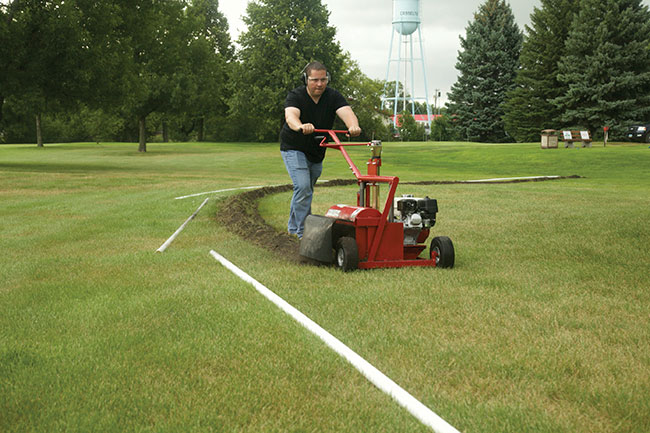
Features
Equipment
Abiding by mini trenching’s dos and don’ts list will help streamline operations
Helpful tips for getting the most from mini trenchers
March 4, 2024 By Joe Haynes
 Mini trenchers not only have compact sizes that can go to places larger trenchers can’t, their pneumatic tires also help to preserve lawns.
Photo credit: Little Beaver
Mini trenchers not only have compact sizes that can go to places larger trenchers can’t, their pneumatic tires also help to preserve lawns.
Photo credit: Little Beaver Whether you have owned a mini trencher for years or you’re renting one for the first time, there are a few dos and don’ts that are important to know beyond the guidelines for basic operation. From safety precautions to backfilling advice, check out this list of tips to keep in mind.
Do select the right mini trencher for the job
While large trenchers are useful for heavy-duty jobs such as installing pipes for water and gas and installing telecommunications, mini trenchers are great for smaller projects, like sprinkler systems, landscape edging and low-voltage wiring. How can contractors choose the right mini trencher for the job? With so many options available, it’s helpful to narrow down the search using important criteria such as the size of the project, the soil type and how deep and wide the trench needs to be.
Some mini trenchers can cut up to 30 feet per minute and dig up to 12 inches deep, making them an excellent choice for the shallow trenching needs of rental store customers, landscape contractors, golf courses and more. Mini trenchers not only have compact sizes that can get to places larger trenchers can’t, but their pneumatic tires also help to preserve lawns. With the ability to easily saw through a variety of tough materials like compacted clay, road fill, asphalt and tree roots up to 10 inches thick, a mini trencher is a great choice for almost any landscape project.
Don’t forget to call before you dig
Calling before digging at least three business days before starting a project is a crucial step when it comes to safety and preventing damage to underground utilities. This free service, available in Canada and the United States, sends professionals to the property to mark the location of underground utility lines, including water, power and gas so contractors know where to dig and what to avoid.
Do plan your path
Another helpful tip is to use marking paint to map the path for the trench after the utilities are marked. This is an easy way to save time and be sure the trencher stays on track. Complete a visual assessment to understand the soil that will be dug through and to check for any obstacles, such as tree roots, that you might encounter along the way. When preparing to trench along a straight path, lock the rear swivel wheel of the mini trencher into position to easily guide it straight ahead.
Do use a proper method for backfilling
Properly backfilling a trench will prevent sinking and settling later. Some mini trenchers simplify the backfill process by creating narrower trenches and depositing the soil neatly on one side of the trench. This allows contractors to backfill 50 per cent faster than models that deposit soil on both sides. Backfill four to six inches at a time, making sure the soil is level and free of debris. This will prevent the occurrence of cupping as the dirt settles.
Don’t push forward if your machine isn’t working
If the mini trencher isn’t working properly, make sure to stop and check out the owner’s manual to troubleshoot. For example, if the cutter wheel quits turning when pushed forward, that usually means the clutch mechanism or drive belts are slipping. In very hard clay soils, contractors can prevent this problem by pushing slowly and letting the machine cut at a slower rate. If the machine binds when trying to raise or lower it, cleaning the guide tubes and lubricating with a graphite or silicon spray should do the trick. Staying on top of routine maintenance is a good bet to ensure optimal performance.
Remember, whether it’s your first time using a mini trencher or the hundredth, it’s important to read the owner’s manual of each new machine you use to ensure the project goes off without a hitch. To learn more about mini trencher best practices, reach out to the manufacturer.
Joe Haynes is president of Little Beaver Inc., a manufacturer of drilling equipment.
Print this page